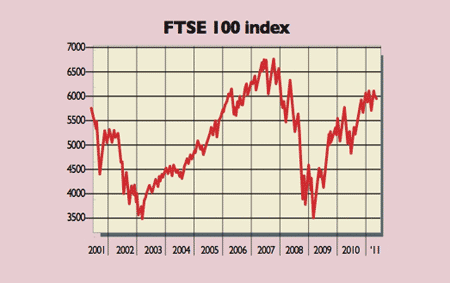
‘Sell in May and go away’ has been a good bet so far this year. The FTSE All-World Index fell around 4% last month and most major markets slid from their post-crisis highs. The end of the US Federal Reserve’s money printing programme in June, which has buoyed all risky assets, is denting confidence, as is the eurozone debt crisis, says Michael Mackenzie in the Financial Times. Economic data have been “faltering” on both sides of the Atlantic, while emerging economies are raising interest rates to fight inflation.
Most major stockmarkets are still only slightly below their post-crisis highs, but government-bond investors, at least, seem severely rattled by the growth outlook. Ten-year yields have slid (reflecting rising prices) by 14%-15% in Germany, the US and Britain in just eight weeks. Bonds are saying that “the industrialised economies are going to see very little growth this year and probably not much growth for a few years to come”, says Morgan Stanley’s Anthony O’ Brien.
Working off high private and government debt loads is likely to keep a lid on growth over the next few years, while history suggests that the next downturn in the developed world’s business cycle “could be just around the corner”, says Richard Milne in the FT. A study of the length of US business cycles since 1854 by Deutsche Bank’s Jim Reid suggests that, based on the mean average length of these cycles,the next recession is due in August 2012. Take the median length of the cycles as a yardstick, however, and the start date jumps to August 2011.
Another worry is that profit margins, which tend to revert to the long-term average, are still near historic highs in the Western world and analysts expect them to rise even further. So there is ample scope for earnings to disappoint, says Morgan Stanley’s Gerard Minack. Stocks, too, are no longer cheap.
While the near-term outlook is discouraging, so is the big picture. US and UK stocks have gone nowhere for ten years, although there have been major ups and downs in this period. Now another dip is threatening to materialise, and a long-term bull run seems unlikely to begin until we have fully recovered from the post-credit-bubble hangover. This sideways market, says Jupiter Asset Management’s Edward Bonham Carter, “has the potential to continue for longer than people may imagine”.
The big picture: US growth not as good as it looks
Official figures often overstate the US economy’s strength, says The Economist. Kevin Daly of Goldman Sachs estimates that, in the ten years to 2008, America’s quarterly GDP growth figure was, on average, revised down by an annualised 0.5% between the first and final published estimates. The final figure often only emerges years later. Eurozone quarterly GDP figures were revised up by an average of 0.3% in that period. It was a similar story in Britain.